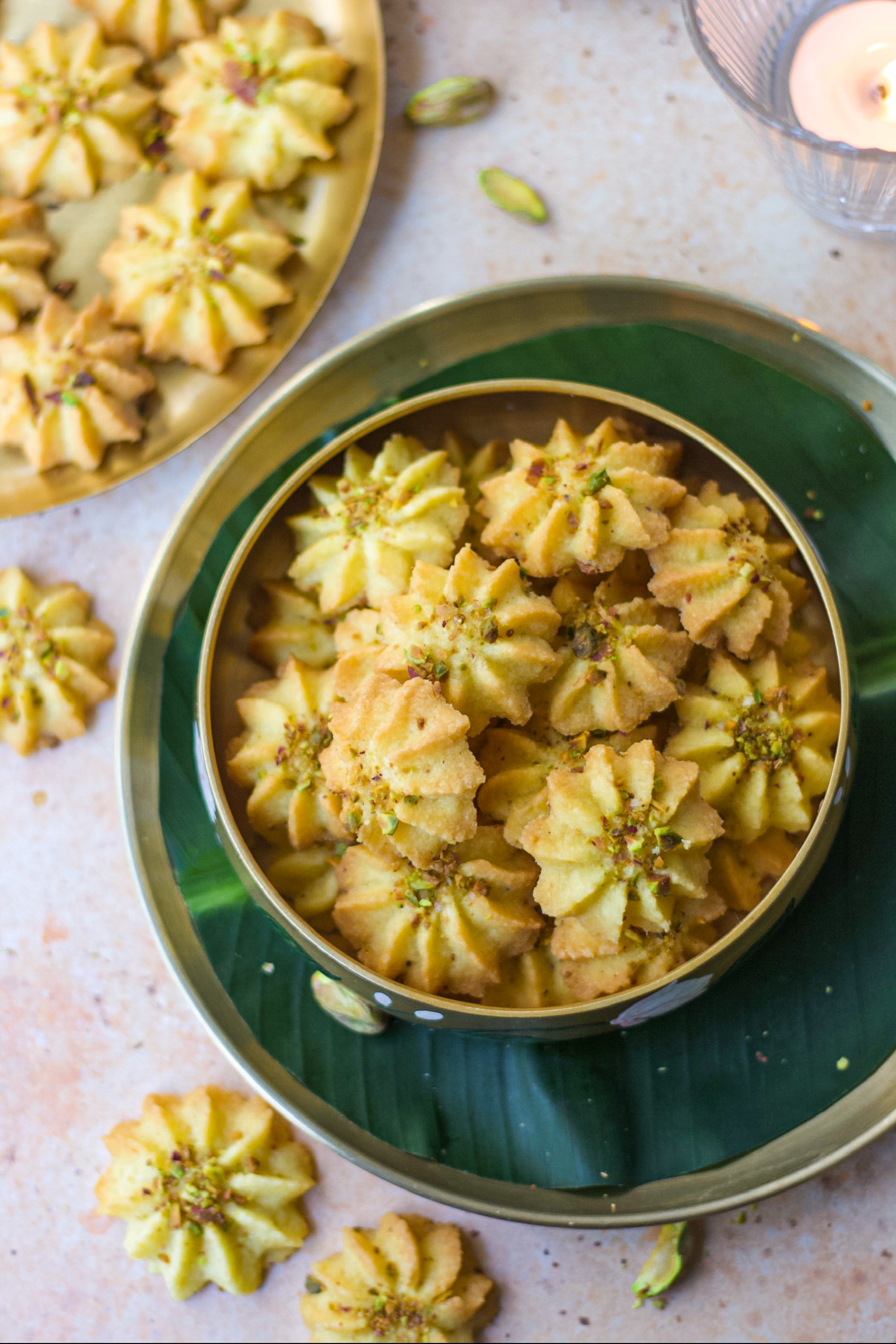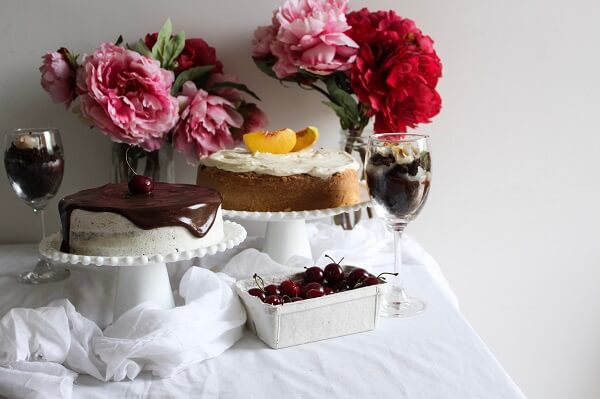The festive season is upon us, and what better way to celebrate than with a delicious fusion of traditional flavors in a delightful cookie form? Rasmalai Cookies—buttery, crunchy, and brimming with the essence of festivity. These cookies are a perfect homage to the classic Indian dessert, rasmalai, but with a unique twist that makes them irresistible for any celebration. Imagine the rich notes of kesar (saffron), pista (pistachios), and the warmth of elaichi (cardamom) blended into every bite. These cookies are not just any treat—they are infused with all the luxurious flavors of the much-loved rasmalai.
The result? A cookie that not only satisfies your sweet tooth but also evokes the spirit of joyous moments. With their melt-in-the-mouth texture and vibrant flavors, these Rasmalai Cookies are a must-try this season!

WHAT YOU’LL LOVE ABOUT IT
- Festive Flavors
- Buttery & Crunchy
- Perfect for Gifting
- Easy to Make
- Fusion Fun

INGREDIENTS USED IN MAKING RASMALAI COOKIES
GHEE (Clarified Butter)
Ghee acts as the fat in the cookie dough. It provides a rich, buttery taste, and due to its low moisture content, it leads to crispier cookies. The nutty flavor of ghee also enhances the traditional Indian flavor, making it more authentic to the rasmalai theme. Since ghee has less water than butter, the cookies will spread less and have a more tender, shortbread-like texture. Ghee brings a unique, toasty aroma that is essential in Indian desserts, complementing the flavors of saffron and milk used in rasmalai.
SUGAR
Sugar sweetens the cookies and also plays a role in the texture. It helps the cookies caramelize, giving them a golden hue and a slightly crispy exterior. It adds sweetness, balancing the flavors of saffron and milk. Sugar adds crunchiness to the cookie. Powdered sugar will make the cookies softer and more tender. Sugar is hygroscopic, meaning it attracts and retains moisture from its environment. In the cookie dough, it ensures the cookies stay moist inside even after baking, which is key in balancing the textures—crispy edges with a soft, tender middle.
ALL PURPOSE FLOUR
Flour provides structure to the cookies. When combined with the fat (ghee), it forms the base of the dough, allowing the cookies to hold their shape while baking. Flour itself is neutral, but it works well with the ghee and saffron milk, allowing these richer ingredients to stand out. The gluten in the flour provides a chewy texture if overworked, but with ghee, it stays more crumbly and soft. The amount of flour directly influences how much cookies spread while baking. If the ratio of flour to ghee and liquid is balanced, the cookies will hold their shape and have a nice thickness. Flour itself doesn’t have much flavor, but it provides a neutral canvas that allows the saffron and ghee to stand out. Its slight nutty undertone comes through in baked goods.
SAFFRON MILK
Saffron milk adds moisture and flavor to the dough. The milk binds the ingredients together, while saffron brings a distinct floral and earthy flavor, reminiscent of traditional rasmalai. The saffron milk adds a slight richness and moisture to the cookies, preventing them from becoming too dry while maintaining a soft, melt-in-the-mouth feel. Saffron provides a luxurious aroma and a golden tint to the cookies, giving them the iconic rasmalai flavor. The subtle infusion of saffron in milk also adds depth to the cookies, making them aromatic and flavorful.

EQUIPMENTS USED FOR RASMALAI COOKIES
A correct proportion of all the ingredients will guarantee the best taste, so you will need measuring spoons and measuring cups to measure quantities of the various ingredients.
Mixing bowls are equally important while baking to combine ingredients and make the dough.
Spatulas and whisks are my favourite tools and I use then as much as the measuring cups and spoons.
You will need a parchment paper or silicone mat to bake the cookies
A open star nozzle to pipe the cookies
TIPS TO MAKE RASMALAI COOKIES
- Ensure the ghee is at room temperature and in a semi-solid state. If the ghee is too melted, the cookies will spread too much, and if it’s too firm, it can affect the creaming process, resulting in dense cookies.
- Bloom the saffron in warm milk for at least 10 minutes to extract its full color and flavor before adding it to the dough.
- Once you add the flour to the wet ingredients, mix only until just combined. Overmixing develops too much gluten, which can lead to tough or chewy cookies.
- Refrigerate the dough for 15-20 minutes before baking.
- Consider using powdered sugar instead of granulated sugar for a melt-in-the-mouth texture.

- 10 kesar strands
- 3 tbsp milk
- ½ cup ghee
- ¼ cup icing sugar
- 1 cup all purpose flour
- 1 tsp cardamom
- Using a mortar and pestle, crush strands of kesar to break them down slightly. Add milk over the crushed kesar and mix well. Set it aside to allow the kesar to infuse and release colour and aroma.
- In a bowl, add ghee and icning sugar. Cream them together using a whisk or spatula until the mixture is light, fluffy, and pale in colour.
- Now add flour, cardamom and kesar milk in it. Combine everthing to form a smooth pipeable dough.
- Transfer the dough into a piping bag fitted with a star nozzle. Pipe out even-sized cookies onto a baking tray lined with parchment paper,
- Garnish the cookies with some crushed pistachios.
- Chill the cookies in the refrigerator for 15-20 minutes, This helps the dough firm up and prevents the cookies from spreading too much during baking.
- Bake the chilled cookies at 180 degrees celsius for 15-20 mins or until the edges are lightly golden.
If you like my easy Rasmalai Cookies recipe and happen to make them in your kitchen, , do tag me on Instagram and share pictures with me using #Bakewithshivesh. Happy Baking!

 Hello. I'm Shivesh Bhatia, a food blogger and food stylist from Delhi, India. Welcome to Bake With Shivesh, where I'll help you create magic in your kitchens with my simple recipes.
Hello. I'm Shivesh Bhatia, a food blogger and food stylist from Delhi, India. Welcome to Bake With Shivesh, where I'll help you create magic in your kitchens with my simple recipes.
Leave a Reply